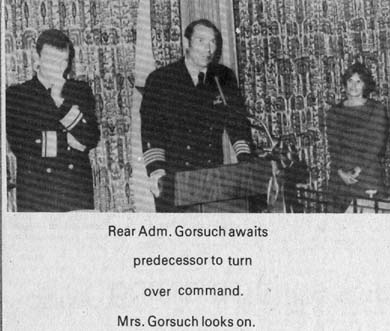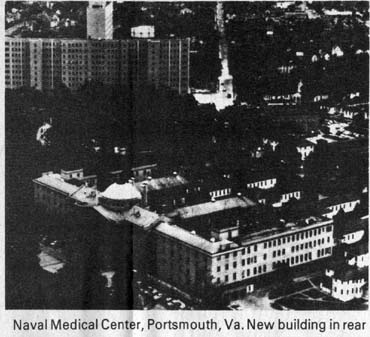April 12, 1979


Picture #1 – Rear Adm. Gorsuch awaits predecessor to turn over command. Mrs. Gorsuch looks on.
Picture #2 – Naval Medical Center, Portsmouth, Va. New building in rear.
PIX #3 – Family Reunion – When Admiral Gorsuch took over command of the Naval Regional Medical Center, it was an occasion for a family reunion. Left to right, they are Rear Admiral Gorsuch; sons Gregory and Geoffry; the admiral’s wife, Jute; daughter Gretchen; Mrs. Esther Gorsuch, and daughters Abby and Emily. Abby is an adopted Korean child.
Rear Admiral George E. Gorsuch, great-great-grandson of John Gorsuch, one of the pioneers of Risdon, which later joined with Rome to become Fostoria, is now commanding officer of the Naval Regional Medical Center, Portsmouth, Va.
When Gorsuch was featured in a Potluck article Nov. 29, 1977, he was stationed in Honolulu.
The naval hospital is the oldest in the United States and the largest Naval Medical Center on the East coast. A permanent landmark in the Tidewater area, the hospital has been providing care for 148 years.
HOSPITAL HISTORY
Historically, the hospital is located on land originally granted to Captain Thomas Willoughby for the growing of tobacco. The land changed hands several times, and in 1176, Fort Nelson was erected on “Hospital Point” to guard the entrance to the towns of Norfolk and Portsmouth.
In 1820, Fortress Monroe was built in Hampton, ending the usefulness of Fort Nelson. The site was then chosen as the location for the naval hospital. In 1827, the cornerstone of the naval hospital was laid. Fort Nelson was dismantled and bricks from the fort were used in the construction of the hospital was the most prominent architectural feature in the Portsmouth area.
In 1855, surgeon Lewis Minor and his assistants were called upon to treat the victims of a yellow fever epidemic in Portsmouth. In gratitude for their heroic efforts, Minor and his staff were given gold medals by the city of Portsmouth.
During the Civil War, the hospital was captured by the Virginia Regiment or the Confederacy. The following year the Union Army recaptured it and returned control to the Navy.
In 1956, work was begun on a new $15 million, 15 story hospital. The new facility was completed and dedicated in 1960, under the command of Rear Admiral H.J. Van Peenan. The original hospital was then renovated and modernized.
The Naval Regional Medical Center, Portsmouth, Va., was established on July 1, 1971, marking the first time in Navy history that the majority of shore based outpatient medical facilities in a given geographic area had merged under the command of a single medically orientated commanding officer.
FAMILY UNITED
When Fostoria observed the bicentennial in 1976, Esther G. Gorsuch, Toledo, mother of Rear Admiral Gorsuch, headed the parade with her grandson Gregory. When Gorsuch took command of the Portsmouth facility last summer, it called for a family reunion and the admiral’s mother was there, as can be seen by one of the accompanying photos, along with Gregory.
Since Gorsuch took over command of the center he has been making news, according to numerous newspaper clippings sent to Potluck.
One story outlined the need for 600 more Navy doctors. However, Gorsuch is not optimistic because of cutbacks in funds.
In another direction, Gorsuch is active in stimulating a program to clean up the old hospital dungeon. It is beneath the original Naval Hospital, built in 1827. Until recently, it has been filled with canned water, crackers, and all the supplies for a civil defense program inaugurated in 1962. All that now has been cleared out, and the 12-room dungeon, complete with iron doors and rusty hooks where manacles supposedly hung, is being restored. The Navy plans to make it a tourist attraction.
It’s one of the best dungeons we’ve ever seen. You just don’t see dungeons like this anymore, says Gorsuch. He says it will be one or two years before the renovation is complete.
Although no one knows for certain, Navy officers believe it was first used for storage, than as cells for mental patients and then prisoners during the Civil War.
Another of Gorsuch’s projects is to give the hospital’s old monument “spit -n-polish. The old monument, located near the original hospital, marks the grave of Army Major John Saunders commanding officer of Fort Nelson during the Revolutionary War.
According to Lt. (j.g.) James Libby, aide and public affairs officer, the dungeon and monument programs are part of a larger program to stimulate interest in the history of the Navy’s oldest hospital.
The stone for the old monument was donated by the man who built the first hospital.
Readers who are interested in history will want to include in their trips to the Norfolk-Portsmouth area a visit to their community’s oldest naval hospital, the dungeon and monument.
READER FEEDBACK
The Kinsey articles brought many comments from readers, too many to list all the names. Comments fell in the categories of: “I remember the Kinsey shows”; “Yes, it always rained when the Kinsey’s came to town”; “The farmers couldn’t make hay when it rained, so they went to the Kinsey show”; “The Kinsey folks were fine people”.
Aileen McPherson remembered that some of the Kinsey folks stayed with her grandmother, Mrs. Drenner, when they were in town. Mrs. Drenner lived at corner of Poplar and Crocker streets, right across from the lot where the Kinsey tent was pitched.
Wanda Harrold remembers her mother, Alta Jane Myers, telling about her recollections of the Kinseys when she was a girl. Her grandfather came to Ohio from Hancock, Md., and settled in Lucas, a village southwest of Mansfield (population today 575). In addition to being a farmer in the Lucas area, Myers also owned an Inn, located on the town’s square. The Kinseys stayed there when they played that area. That goes back to the days when M.L. Kinsey came to Ohio and introduced his shows. Wanda says her mother related how the children would attend the shows and then put on their own little imitation acts.
Loy Luman contributed an interesting story. His mother was devoted to the Kinsey shows when they played Fostoria. In 1915 she was pregnant but still attended. One of the presentations was Lena Rivers. She admired the ability of the leading actor Loy Durwood Belmont. When Mrs. Luman’s child was born he was named Loy, after the actor.
Henrietta Croxford reported that an old frame building that at one time was located west of the Ghaster Building on the corner of Sandusky and Fremont, at end of north Poplar, was used by Kinsey as a storehouse for their equipment. She remembers the Kinsey players and going to Kinsey shows.